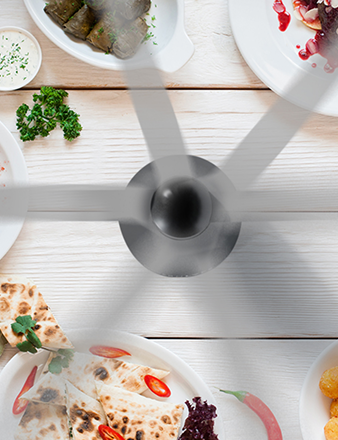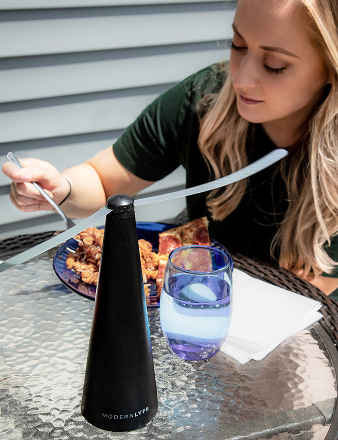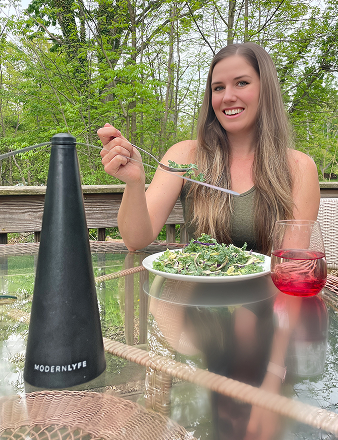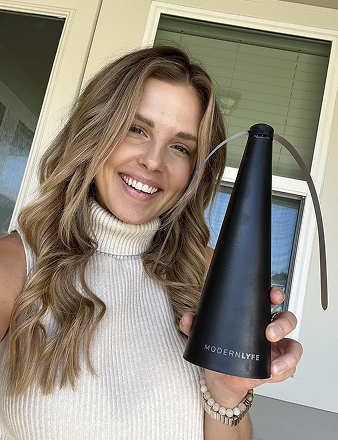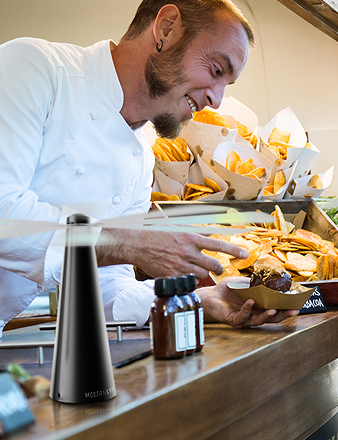You've got a swarm of tiny, annoying guests buzzing around your kitchen fruit bowl. You want them gone, fast. It's tempting to light a citronella candle, but will it actually solve your fruit fly problem?
Let's get straight to the point: No, not really. Citronella is great for keeping mosquitoes away from your backyard BBQ, but it's useless against fruit flies.
Why Citronella Fails
Think of a citronella candle as the wrong tool for the job. While products like the Citronella Jewelry Ring Candle Travel Tin Gift Set are effective for keeping your patio mosquito-free, they aren't designed for the unique challenge of fruit flies.
It all comes down to what drives each insect. Fruit flies are on one mission: find fermenting sugar. That overripe banana on your counter sends out an aroma that’s an irresistible siren song. The lemony scent of citronella might be unpleasant to them, but it’s nowhere near strong enough to overpower the smell of a feast.
The problem is a scent mismatch. Citronella works by scrambling the signals of insects that hunt for CO2 and body odor, like mosquitoes. Fruit flies are like tiny guided missiles locked onto the sweet, potent scent of decay.
This is why you can have a citronella candle burning right next to your fruit bowl and still have a fruit fly party. They are too focused on their target to be deterred by a scent they don't care about.
Also, keep in mind that citronella oil can be toxic to pets if ingested, so using it indoors is a risk you don't need to take.
While citronella is a dead end for fruit flies, don't worry. There are much more effective methods available. For a deep dive into what actually works, check out our complete guide on https://modernlyfe.com/blogs/articles/how-to-control-fruit-flies.
How Scent Masking Actually Works
To understand why citronella candles fail against fruit flies, you need to know how they're supposed to work. Citronella isn't an insecticide; it doesn't kill pests on contact. Instead, it’s a powerful olfactory disruptor—it messes with an insect's sense of smell.
Imagine trying to find a specific bakery in a crowded mall by following the smell of fresh bread, but someone opens a giant vat of perfume next to you. The overpowering floral scent completely masks the smell you're looking for. That's what citronella does to certain insects, creating a scent camouflage that hides the smells they're trying to find.
The Mosquito vs. The Fruit Fly
This scent-masking trick works pretty well against mosquitoes. Mosquitoes hunt for the carbon dioxide (CO2) we exhale, along with other subtle body odors. The potent, lemony aroma of burning citronella creates a confusing "smokescreen," making it much harder for them to zero in on their next meal—you.
But here's the catch: that same strategy is useless against fruit flies. Fruit flies don't care about CO2 or body odor. Their entire existence is programmed to follow the powerful scent signals from fermenting sugars in decaying fruit and vegetables.
A rotting banana on your counter is a blaring foghorn to a fruit fly. The scent of a nearby citronella candle is a gentle wind chime in a hurricane—it's just not strong enough to compete.
This infographic clearly shows the difference in how these pests operate.

As you can see, citronella’s scent masking is a decent match for a mosquito's senses, but it’s completely overpowered by the lure that guides fruit flies. The intense call of a food source will almost always win, which is why pairing citronella candles and fruit flies is such an ineffective combo.
Here’s a quick breakdown of how citronella stacks up against different pests.
How Citronella Affects Different Pests
| Pest Type | Primary Attractant | How Citronella Interferes |
|---|---|---|
| Mosquito | Carbon Dioxide (CO2), Body Odor | The strong scent masks subtle chemical cues, making it hard to locate a host. |
| Fruit Fly | Fermenting Sugars (Rotting Produce) | The scent of decaying fruit is far more potent, easily overpowering the candle's fragrance. |
| Gnat | Fungus, Moisture, Decomposing Organic Matter | Similar to fruit flies, the attractants in soil and drains are often stronger than the citronella. |
Ultimately, a repellent is only as good as its ability to disrupt the right signal. For mosquitoes, it works. For fruit flies, it's like trying to shout over a rock concert—you're just not going to be heard.
Why a Candle Is the Weakest Delivery Method

Let's be real: even if citronella oil was the ultimate fruit fly kryptonite, using it in a candle is like trying to put out a bonfire with a squirt gun. The problem isn't just the oil; it's the delivery system.
When you light a citronella candle, it releases a weak, inconsistent puff of scent and smoke. This creates a tiny, localized "bubble" of aroma that barely extends beyond the flame. The slightest breeze—or even someone walking by—can scatter this fragile scent cloud, rendering it useless. For fruit flies buzzing on the other side of the room, it might as well not be there.
Concentration Is Key
The real difference between a useless candle and an effective repellent is the concentration of the active ingredient in the air. A candle slowly melts scented wax, a passive, low-energy way to release the oil. It simply can't pump out enough scent to create a real protective barrier.
A candle creates a small, smoky bubble of scent that easily dissipates. An active delivery system, like a diffuser, creates a consistent, room-filling protective shield by saturating the air with pure oil.
A 2009 study put this to the test. When comparing citronella candles to diffusers for mosquito repellency, the results were stark. The candles only achieved a 14% repellency rate indoors. The diffusers, which actively push pure oil into the air, hit a 68% repellency rate. That gap makes it clear: how you spread the oil matters more than just having it in the room.
Better Delivery Systems for a Pest-Free Zone
If you're committed to using scent to keep pests away, you need an active dispersal method. Devices like diffusers, which use fans or ultrasonic vibrations, are designed to fill a space with a steady, concentrated vapor. This creates a much more powerful and reliable barrier.
But for dependable fly control, especially around food, disrupting their flight is often a better bet than masking smells. This is where people often ask if fly fans work as a better alternative. In the end, relying on the weak scent from citronella candles for fruit flies is a strategy that's guaranteed to disappoint because the delivery system is fundamentally flawed.
Maximizing Citronella for Outdoor Gatherings
While citronella is a bust for fruit flies indoors, it can definitely help at outdoor events. Used correctly, that familiar lemony scent helps keep mosquitoes and other buzzing party crashers away, making your patio hangout much more pleasant.
The secret isn't just lighting a candle; it's about strategy.
Forget sticking one lonely candle in the middle of the picnic table. That’s like trying to shield a party from a downpour with a cocktail umbrella. To get any real effect, you need to create a perimeter of protection around your seating area.
This method works by building a higher concentration of citronella scent right where it matters—where you and your guests are. By surrounding the space, you create a more potent scent barrier that pests are less likely to cross.
Creating Your Scent Barrier
Setting up this protective zone is simple, but it requires more than a single candle.
-
Go for Numbers: You'll want at least three to four candles for a typical patio table or small seating area. The bigger the space, the more candles you need.
-
Strategic Spacing: Place the candles on the ground or low side tables around the outer edge of your gathering, spaced about 6 to 8 feet apart.
-
Mind the Wind: A breeze can be your best friend or worst enemy. Always place the candles upwind of your seating area. This lets the wind naturally carry the scent through your space instead of blowing it away.
The most effective pest control combines repellents with good old-fashioned cleanup. Making your space less attractive to flies in the first place is half the battle.
Citronella candles are just one part of your pest-fighting arsenal. For them to work well, you also have to get rid of what attracts flies.
They are a great addition to a broader strategy for managing pests on your terrace or in the garden. Basic hygiene—like clearing away food scraps and keeping trash cans sealed—should always come first. The candles enhance those efforts, releasing a fragrant smoke that tells flying insects to keep their distance. If you're interested in more natural solutions, you can also learn more about creating a pest-free garden with fragrant plants.
Smarter Ways to Eliminate Fruit Flies

Since we know citronella candles for fruit flies are not the answer, let's focus on what works. The most effective strategy isn't about weak repellents; it's a two-pronged attack that combines elimination with prevention.
This approach means you're not just swatting at the problem. You're trapping the flies you have now while cutting off the resources they need to breed. It’s how you solve the infestation at its source.
Build a Better Fruit Fly Trap
You don't need to buy fancy gadgets. One of the best fruit fly traps can be made with items you already have in your kitchen. This simple DIY trap lures pests in with a scent they can't resist and ensures they can't get back out.
Here’s the classic recipe that always works:
- The Bait: Pour about an inch of apple cider vinegar into a jar or small bowl. Fruit flies are obsessed with the smell of fermentation.
- The Secret Weapon: Add a couple of drops of dish soap. This is crucial—it breaks the vinegar's surface tension, causing the flies to sink the moment they land.
- The Funnel: Roll a piece of paper into a cone and stick it into the top of the jar, leaving a tiny opening at the bottom. Flies can easily get in but are not smart enough to find the exit.
If you want to explore more trapping methods, our guide to building the ultimate fruit fly catcher has you covered. Place a couple of these traps near your kitchen sink or fruit bowl, and you'll see a big difference in a day or two.
Prevention: The Ultimate Solution
Trapping takes care of the current flies, but prevention stops them from coming back. Fruit flies seek two things: moisture and rotting organic matter. The trick is to make your kitchen a terrible place for them to live.
Start by cleaning their favorite hangouts. Wipe up spills immediately, take out the trash often, and don't let dirty dishes pile up. A quick wipe-down of your counters and a rinse of recyclables will remove the sticky residue they feast on.
A single female fruit fly can lay up to 500 eggs on a piece of overripe fruit. With a life cycle of just over a week, a few flies can explode into a full-blown infestation overnight.
For a foolproof line of defense, think about physical barriers. Installing high-quality, effective insect screens and fly screens on your doors and windows is a simple way to stop pests from ever getting inside.
Your Questions About Citronella Answered
Let's cut through the confusion. When you get straight answers about citronella and fruit flies, you can stop wasting time and get right to what works.
Here are the most common questions, answered directly.
Do Citronella Candles Kill Fruit Flies?
No. Citronella candles are not insect killers. Think of them as bouncers, not assassins—their job is to repel, not eliminate.
Citronella oil creates a scent that confuses insects like mosquitoes by masking the smells they use to find you. But fruit flies are hard-wired to track the powerful scent of fermenting fruit, and the faint smell of citronella isn't enough to throw them off. To actually kill them, you need a trap, like the apple cider vinegar method.
Is It Safe to Burn Citronella Candles Indoors?
I strongly advise against it. Burning a citronella candle inside is not a good idea. They are almost all made for outdoor use for a reason. In an enclosed space, they can create sooty smoke that ruins your air quality.
There's also a serious risk to pets.
Citronella oil is toxic to pets if ingested, and the concentrated smoke can irritate their lungs, especially without good airflow. It's always better to be safe and keep these candles strictly outdoors.
How Many Candles Do I Need for My Patio?
One candle on a big patio won't do much. For real protection against mosquitoes, you need to create a perimeter of scent.
A good rule of thumb for an average-sized deck is at least 3-4 candles. Don't cluster them together. Place them around the edges of your space, a few feet apart. This builds a "scent fence" that makes it much harder for flying insects to wander into your party.
Why Are Fruit Flies Still Landing on My Fruit?
You have a citronella candle burning, but fruit flies are still partying in your fruit bowl. Why? It's a matter of motivation. To a fruit fly, a bowl of ripening bananas is a five-star meal with an incredibly powerful scent.
The candle's scent is a mild annoyance, but the fruit's smell is an irresistible feast. The flies will push right through the citronella to get to it. The only surefire fix is to remove their target—put the fruit in the fridge and keep your counters free of crumbs and spills.
Ready to clear the air for good? The MODERN LYFE fly fan creates a gentle, pest-free zone over your food without any smoke or chemicals. Discover the smarter way to protect your meals and gatherings today!

